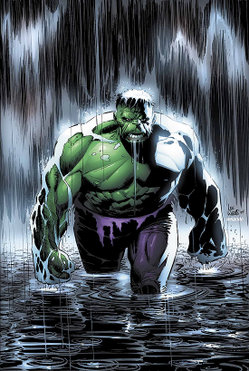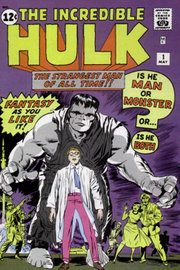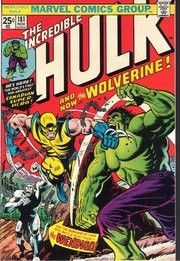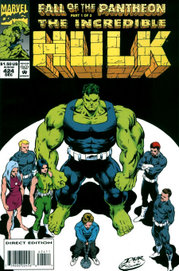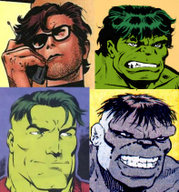Hulk
The Hulk, often called the Incredible Hulk, is a Marvel Comics superhero. Created by Stan Lee and Jack Kirby, he first appeared in Incredible Hulk v1 #1 (May 1962), and has since become one of Marvel's most iconic characters, usually ranked second only to Spider-Man in terms of name value. more...
Publication history
The Hulk was inspired by the story of Mary Shelley's Frankenstein, or The Modern Prometheus and Robert Louis Stevenson's Dr. Jekyll and Mr. Hyde, the dichotomy usually consisting of the simple-minded and emotional brute who springs from a quiet intellectual. Indeed, in contrast to the quiet Banner, the most famous version of the Hulk is as a childlike persona who just wants to be left alone, but is continually forced to battle foes determined to hunt him down. This is somewhat similar to that of Universal Studios's 1931 film, Frankenstein, another major influence on the character.
History of the comic
In the first issue of The Incredible Hulk, the Hulk was supposed to be gray. However, the publishers of the time had difficulties with printing a consistent and clear shade of gray, so after the first issue Stan Lee decided to make him green and that color stuck. Subsequent reprints of that story retroactively changed the Hulk's skin to green, creating the (false) impression that he had been that color from the beginning. Later in the series, in 1986, the Hulk reverted to gray, and remained that way until 1991.
In the origin story of the Hulk, Dr. Bruce Banner is a military scientist who has developed a new type of weapon called the "Gamma Bomb". As the bomb is being tested (in a fashion reminiscent of the Trinity atomic bomb test), Dr. Banner notices that a teenager, Rick Jones, has driven his car onto the test site. Banner races out into the open to bring the young man to safety, but the bomb explodes before he can reach safety himself. Banner is subjected to an incredible dose of gamma rays, and this is what causes him to transform into the rampaging Hulk. This story has a strong Cold War subtext to it: in addition to the Gamma Bomb test, the Hulk is promptly captured in the first issue of the book and brought to a country which is presumably the Soviet Union (though the name "Soviet Union" was never used in the book, the story ended with a statement about the end of "Red tyranny" and the story's reformed villain cursing a picture of then-Soviet Premier Nikita Kruschev). Later revisions of the Hulk's origin (especially for the TV series of the 1970s and the animated TV cartoons of the 1980s and 1990s) remove the military subtext and make Banner a civilian scientist (though still working on a military base in most versions bar the TV series).
At first Banner becomes the Hulk only when the sun goes down, reverting to his human form at sunrise, but soon he creates a machine that can transform him into the Hulk at will. (The more familiar trigger for the transformation, whenever Dr. Banner becomes angry or emotional, would not be established until later.)
The plots of many of the earliest Hulk stories involve General Thaddeus E. "Thunderbolt" Ross continually pursuing the Hulk, with his "Hulkbuster" U.S. Army group at his side. Ross's daughter Betty is a love interest for Bruce Banner and often criticizes her father for going after the Hulk so relentlessly without regard to her feelings for the Hulk's alternate identity (whom General Ross has little respect for in any case, referring to him as a "milksop" and bemoaning his daughter's infatuation with an intellectual). General Ross's right-hand-man, Major Glenn Talbot, is also in love with Betty but is an honorable man and is torn between pursuing the Hulk and gaining Betty's love in an honest way. Teenager Rick Jones is the Hulk's first and only friend for a time. Later on, another teenager named Jim Wilson becomes the Hulk's friend.
The Hulk appeared in the premiere run of his own comic book series created by Stan Lee and Jack Kirby during the early 1960s, at the same time as other famous Marvel characters including the Fantastic Four, Thor, and Spider-Man. The initial Hulk series only ran for six issues before being cancelled by Marvel, due to low sales and the limited number of titles Marvel was then allowed to publish: in order to free space on the publishing schedule and give Spider-Man his own comic, The Hulk was cancelled. However, the character's brief run was popular enough to be noticed by creators Kirby and Lee. In interviews, Kirby stated that shortly after the official cancellation notice for the book was issued, he received a letter from a college dormitory stating that the Hulk had been chosen as its mascot. Kirby and Lee realized that their character had found an audience in college-age readers — a demographic that had been entirely ignored by comic books until that time. This inspired them to keep the Hulk alive through numerous guest appearances in other comic books, and by adding him to the founding ranks of the Avengers. Even though his membership in that group was remarkably short-lived (quitting the team in the second issue), he also featured as an adversary in 2 other issues. He teamed up with the Sub-Mariner in issue #3 and battled (then inadvertently helped) the Avengers in #5. Due to the Hulk's new-found popularity among Avengers fans, he was given a regular backup feature in Marvel's ongoing series Tales To Astonish which started four months after his last appearance in Avengers #5. It featured Stan Lee's writing with Steve Ditko illustrating. During that run, it was established that Banner's condition changed to that he became the Hulk when experiencing extreme emotional stress, most notably terror and especially anger. While the credit for this idea is unclear, it helped make the character a cultural archetype of uncontrolled emotion, and is by far the most famous element of the Hulk's backstory.
After several years, Astonish, which at the time featured the Hulk and Sub-Mariner in half-length stories, was split up into two full-length comics. The Incredible Hulk continued the numbering of Astonish with issue #102 (1968), where its run continued until March 1999, at which point the series restarted with a new issue #1. The third and current Hulk series premiered in April 1999, with the title being returned to The Incredible Hulk with issue 12.
Read more at Wikipedia.org

